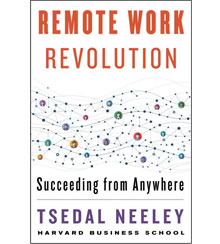Tips for leading people at a distance
As many companies adopt hybrid work models, Harvard Business School professor Tsedal Neeley’s new handbook for managing remote workers is a timely read.
Remote Work Revolution: Succeeding from Anywhere
by Tsedal Neeley, Harper Business, 2021
It seems less and less likely that the pandemic will be the impetus for a permanent, wholesale shift to remote work. Sure, employee sentiment polls find that most people like working from home, and anecdotal evidence suggests a few of them will refuse to return to the office if and when their leaders summon them. But the US Bureau of Labor Statistics reports that only 16.6% of employed persons teleworked or worked at home because of the coronavirus in May 2021, down from 18.3% in April. Moreover, few CEOs of major companies are wholeheartedly embracing remote work: some, like Jamie Dimon of JPMorgan, are rejecting it altogether, and many, including Tim Cook of Apple, are offering some form of hybrid work instead.
This suggests that the title of Harvard Business School professor Tsedal Neeley’s new book, Remote Work Revolution, is something of an overstatement. Indeed, in the book’s introduction, Neeley reports that JPMorgan “is considering a permanently remote workforce”—which isn’t happening. But that doesn’t mean leaders shouldn’t read the book. It is, after all, more and more likely that leaders will be called upon to manage people who are working remotely some of the time. That is, if they aren’t already responsible for distributed teams, salespeople, and other employees whose work takes them on the road, or mixed teams of full-time employees and external contractors. And they will need to be prepared.
“For workers and leaders around the world,” explains Neeley, “untrained remote work isn’t a panacea. In fact, you may have experienced some or all of the many challenges that are inherent in virtual arrangements.” The challenges for leaders include keeping people connected when they aren’t in the same place, building trust and alignment without in-person contact, avoiding Zoom fatigue and other technological pitfalls, creating viable boundaries between work and private lives, and transferring highly coordinated work to distributed settings.
Remote Work Revolution addresses these challenges and more in a handbook format. Each chapter poses a question (“How should I use digital tools in remote work?”) and, drawing on her own and others’ research, Neeley answers it with practical and nuanced advice. In the case of digital tools, for instance, she explains that when choosing the best communications media, the existing relationships among team members can be a more important consideration than the type of information being conveyed. If team members have already established positive relationships and know one another well, email alone can be adequate for negotiations and decision-making. “On the other hand,” writes Neeley, “teams whose members have neutral relationships—for example, teams formed randomly by lottery or location—do achieve better outcomes when they communicate via richer media types [such as videoconferencing], perhaps because they need more information about how the others think and act.”
As you might expect, one of the challenges of leading remote workers is ensuring that they share a clear understanding of four key areas: their goals, their individual roles, the resources at their disposal, and the norms that will govern their interactions. This alignment can be hard to achieve when employees are co-located. But it becomes even more difficult when they are working separately and at a distance. As a result, Neeley says that leaders of remote workers should ensure alignment by first conducting a launch session and then following up with repeated relaunch sessions. “Relaunches are periodic appraisals of how the group is faring with four key areas,” she writes. “As a general rule, teams should revisit their standing via a relaunch at least once per quarter. When people work remotely, I have found that relaunching every six to eight weeks to orient or reorient based on evolving dynamics is more important.”
Remote workers must share a clear understanding of their goals, their individual roles, the resources at their disposal, and the norms that will govern their interactions.
Neeley puts her expertise in the communication dynamics within global companies—the topic of her first book, The Language of Global Success (Princeton University Press, 2017)—to particularly good use. Alignment remains a major challenge in remote global teams. But cultural and language differences can easily exacerbate it by adding psychological distance to physical separation. To overcome the barrier of language, Neeley advises leaders to encourage team members who are fluent in English to speak at a slower pace and to use familiar language (as opposed to slang and idioms), and to encourage those who are less fluent to speak up more and to stop the conversation when they don’t understand something. Leaders themselves should actively seek a “balanced inclusion” that ensures that everyone in the group has roughly equal time to speak and listen.
Although it is likely that the demise of the office is, as Mark Twain reputedly said on hearing reports of his death, greatly exaggerated, the ability to effectively manage remote workers is equally likely to become a requisite skill set for leaders. You can obtain it through trial and error, or you can get a leg up by reading Remote Work Revolution.
Author profile:
- Theodore Kinni is a contributing editor of strategy+business. He also blogs at Reading, Writing re: Management and is @TedKinni on Twitter.






